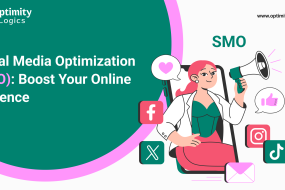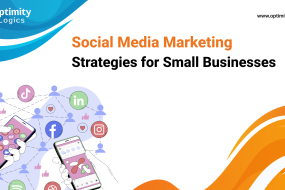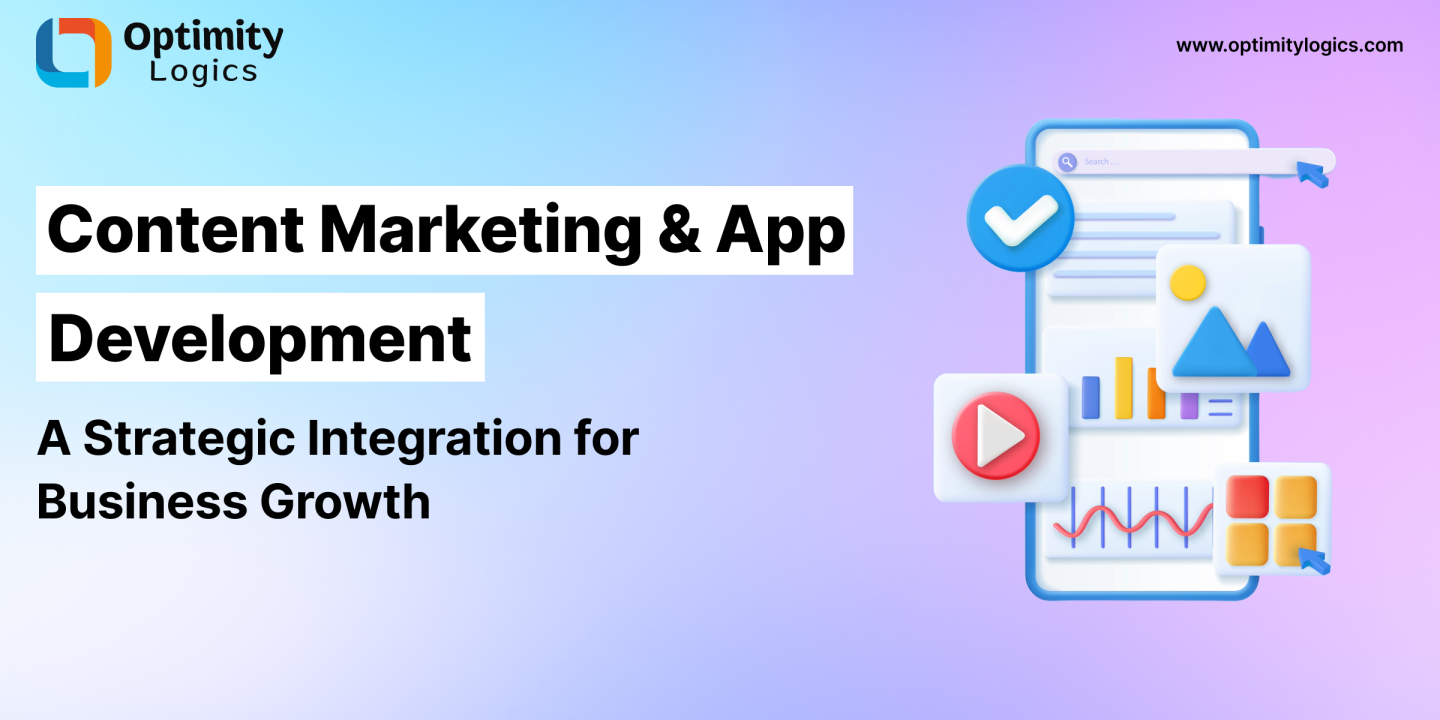
In today’s digital-first economy, mobile applications have become indispensable tools for engaging users, delivering services, and creating personalized experiences. At the same time, content marketing has proven itself as one of the most effective ways to build brand awareness, trust, and authority.
But what if these two powerful strategies could work together rather than independently?
The convergence of content marketing and app development opens up a powerful avenue for businesses looking to expand their reach, boost user engagement, and provide value beyond the traditional app interface. This blog will dive deep into how integrating content marketing with app development creates a stronger brand presence, increases user retention, and fuels long-term business success.
Why Integrating Content Marketing into App Development Matters
Many businesses treat app development and content marketing as separate entities. App developers focus on user interface (UI), user experience (UX), functionality, and speed. Content marketers, on the other hand, work to create valuable, relevant content that attracts and engages a clearly defined audience.
However, the modern user doesn’t see these as separate. When they open an app, they expect not just seamless functionality but valuable content experiences—tips, tutorials, articles, push notifications, personalized recommendations, and more.
Integration brings alignment, allowing both disciplines to work towards the same user-centric goals.
The Benefits of Integrating Content Marketing and App Development
1. Boosts User Engagement and Retention
When your app provides fresh, personalized, and helpful content, users are more likely to come back. Whether it’s news updates, blog posts, videos, or educational guides, strategically placed content within an app keeps users engaged beyond the app’s core functionality.
- Push notifications for new content
- Personalized content based on user behavior
- In-app blog posts or tutorials
- Interactive content such as quizzes or polls
2. Enhances the User Experience (UX)
By anticipating users’ questions or problems and addressing them with embedded content, you make their journey smoother. For example, onboarding tutorials in a fitness app or FAQs in a banking app serve as content-driven UX enhancements.
This approach shortens learning curves, increases satisfaction, and lowers abandonment rates.
3. Drives Organic App Growth Through SEO and Sharing
While app stores are the primary discovery channel, integrating content marketing within your app also creates secondary acquisition channels:
- Shareable in-app content leads to backlinks and new users.
- Embedded blogs with proper SEO can rank on search engines.
- Social sharing options embedded in app content drive word-of-mouth traffic.
4. Strengthens Brand Authority
Publishing regular content within your app builds your brand’s voice and thought leadership. When users turn to your app not just for features, but for expert insights or helpful articles, your brand builds authority and trust.
This is particularly useful in industries like finance, healthcare, education, and fitness where ongoing guidance and thought leadership are valued.
Key Ways to Integrate Content Marketing into App Development
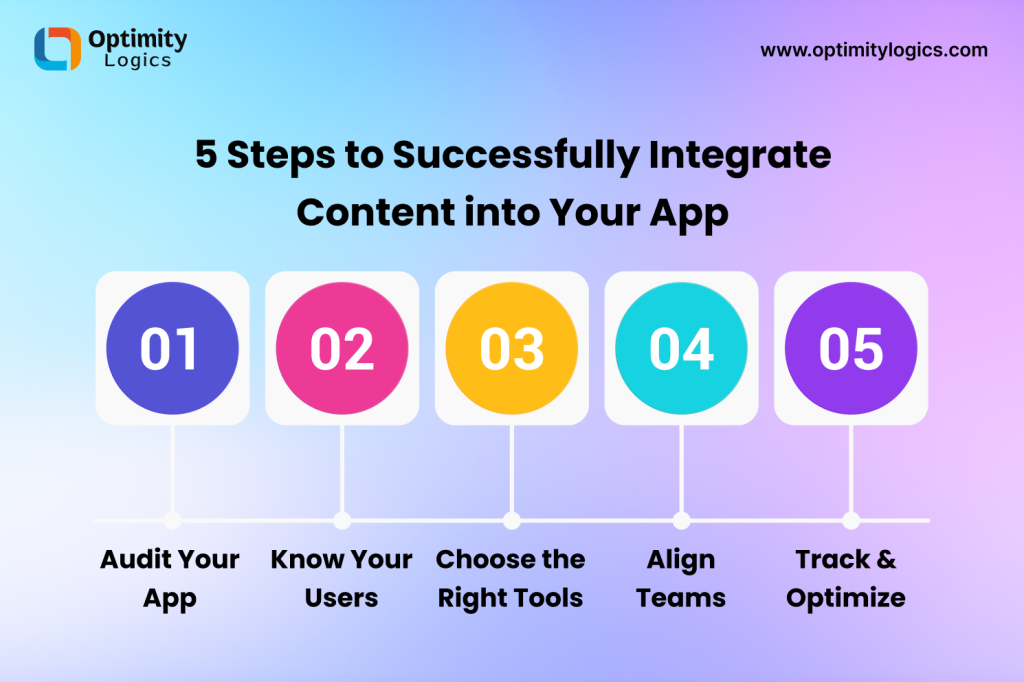
1. Plan Content as Part of App Features
Don’t treat content as an afterthought. Plan it from the very beginning of your app development cycle. Ask:
- What kind of content will users benefit from?
- How can content enhance core functionality?
- Should content be static or updated regularly?
For example:
- A meditation app can include a daily blog or mindful tip.
- A travel booking app can offer destination guides.
- A recipe app can have nutrition articles or cooking videos.
2. Use a CMS That Supports In-App Content
To make content delivery smooth, use a Content Management System (CMS) that can push content directly into the app. CMS solutions like Contentful or Strapi can be integrated with both web and mobile platforms.
Benefits:
- Easily update content without releasing app updates.
- Schedule or automate content publishing.
- Localize content for regional audiences.
3. Optimize Content for Mobile Consumption
Your in-app content must be mobile-first:
- Short paragraphs
- Scannable headings
- Visuals and icons
- Dark mode compatibility
- Touch-friendly interactions
You’re not just repurposing website content—you’re reimagining it for mobile users on the go.
4. Leverage Push Notifications for Content Promotion
Push notifications are a powerful bridge between content marketing and mobile app strategy. Use them to:
- Notify users of new blogs or videos.
- Alert users to personalized recommendations.
- Deliver daily tips or motivational content.
However, balance is key. Notifications should be timely, relevant, and permission-based to avoid user fatigue.
5. Track Content Performance Within the App
Use analytics to measure how users interact with your in-app content:
- What articles or videos are most viewed?
- How long do users spend reading?
- What type of content leads to conversions?
- Are users sharing your content?
This data allows you to refine both content strategy and app functionality based on real behavior.
Case Study: Content-Driven App Success
Let’s take an example of a fitness mobile app. Instead of focusing only on workouts and calorie tracking, the app also integrates:
- Weekly blog posts about nutrition
- Articles on sleep optimization
- Daily motivational push quotes
- Embedded YouTube workout videos
- A community Q&A section
This combination leads to:
- Increased daily active users (DAUs)
- Lower churn rate
- More organic growth through shared content
- Improved brand loyalty
It’s no longer just a fitness app—it’s a full content ecosystem that supports a healthier lifestyle.
Challenges in Integration – And How to Overcome Them
1. Team Silos
Often, app developers and content marketers work in separate teams with different goals. This disconnect causes disjointed user experiences.
Solution: Align both teams early. Use collaborative planning tools and workflows to bring content and functionality together from the start.
2. Technical Limitations
Developers may be concerned about app performance or bloat caused by dynamic content.
Solution: Use lightweight content formats (like Markdown), efficient image compression, and lazy-loading strategies to keep the app smooth.
3. Content Overload
Users may feel overwhelmed by too much in-app content.
Solution: Personalize and segment content. Use machine learning or simple filters to deliver relevant content based on user interests or behavior.
How Businesses Can Get Started
If your business is ready to enhance its mobile app strategy through content marketing, here are the steps to begin:
- Audit your existing app for areas where content can add value.
- Identify your user personas and map content that meets their needs at different journey stages.
- Define content formats—blogs, videos, how-tos, infographics.
- Select tools—CMS, push notification platforms, analytics.
- Collaborate across teams—developers, marketers, designers.
- Pilot and test—start small, measure impact, and scale what works.
Working with a team that understands both technology and strategy can significantly ease this process. A digital solution partner like optimitylogics can help bridge the gap between mobile UX and strategic content delivery to maximize user engagement.
The Role of Digital Marketing Services in Content-Driven App Strategy
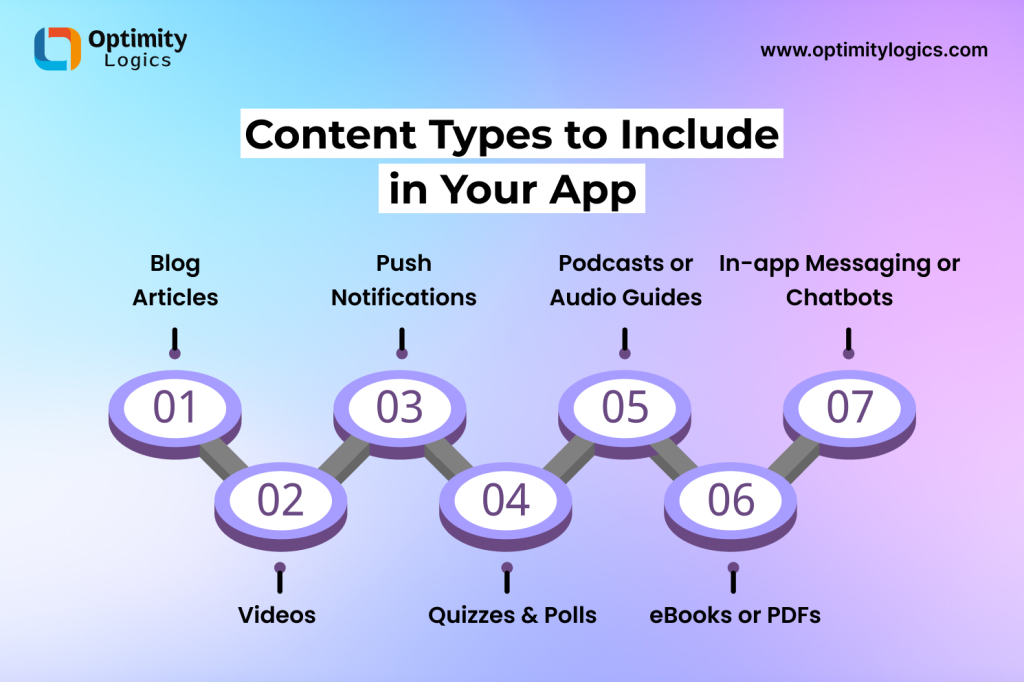
Mobile apps are more than just tools; they’re platforms for brand storytelling and value creation. Integrating content into your app enhances its stickiness and reach—but it doesn’t stop there.
To amplify the reach and impact of your in-app content, it’s crucial to invest in professional Digital marketing services. These services ensure that your content is:
- Promoted via social and search ads
- Optimized for discoverability (ASO and SEO)
- Supported by email campaigns
- Amplified through influencer and community marketing
With the right strategy, your app becomes not only a functional product but also a content hub that drives continuous engagement and conversion.
Conclusion
As users become more demanding and competition increases, the apps that succeed are those that provide value beyond utility. By integrating content marketing into your mobile app development strategy, you move from simply offering a service to delivering a complete, engaging experience.
This synergy improves user retention, enhances UX, boosts discoverability, and builds stronger emotional connections with your audience.
Whether you’re building a new app or enhancing an existing one, now is the time to consider how content can elevate your app strategy—not just as an add-on, but as a core component of your business growth.


